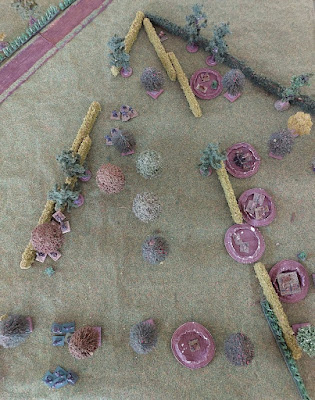Introduction
This is game 69 in play testing my ancient rules by
replaying historical battles. I started
by using my own rules Ancients Battlelines Clash (ABC) but recently using a
similar set of my rules, When Warriors Collide (WWC). I recently updated ABC with some learnings
from WWC, so back to using ABC! I am play
testing rules by replaying all the Peter Sides scenarios from his Historical
Battles books, and some others I find along the way. ABC is designed to finish in around 30
minutes on a 2’x2’ or smaller table; I am currently using a 40cmx40cm table.
Battle of Naissus, 268 AD
The Goths invade Greece and Roman Emperor Gallienus
march an army to meet them.
Scenario source: Peter Sides Ancient Historical
Battles Volume 2.
Link(s):
Wikipedia:
https://en.wikipedia.org/wiki/Battle_of_Naissus
Troops
Romans (Gallienus)
2 LDR, 2 HC, 2 LC, 2 HI, 1 MI, 2 LA.
Breakpoint: 2.5
Goths
2 LDR, 2 HC, 5WB, 2 LI, 1 Camp
Breakpoint: 3.5
Scenario
Map: Open.
Special rules: The Gothic camp is a laager. It is twice the size of normal camp and if
defeated is not looted and stay on the table and cannot be attacked again. It does count as lost breakpoints though.
Deployment

Deployment, Romans on the left
Romans (Gallienus):
LC HC* LA MI HI* HI LA HC LC.
Goths:
HC* LI WB WB WB WB WB LI HC*
Game
Gallienus needs to win the left flank where he is
slightly stronger. Should be able to
hold the centre and their right flank for long enough to win. Alternatively, hope to win the centre.
Gallienus advances all his units. On the left flank, Gallienus Heavy Cavalry advances to close enough to the Gothic Heavy Cavalry that they must charge (into both the Light Cavalry and the Heavy Cavalry).

Gothic leader (right) charging the Roman left flank cavalry
The Light Cavalry missile fire forces the Gothic cavalry back
The Warband line advances. The Roman Light Archer fire and one Warband in response charges them, and the Auxilia next to them. The Warband routs the Light Archer.

Warband in melee with the Light Archer. It will rout.
The next turn the remaining Light Archer fires on the Warband that charges it and the Light Archer is disordered.

The other Light Archer in melee. It is only disordered.
This is a chance for the Romans to hit the centre Warbands – the outer Warband are engaged (with the Auxilia and the Light Archer and so with a leader present the Romans may be able to win against the three Warband. They give it a go. All four units in melee are disordered.
On the Roman left flank, the Gallienus Heavy Cavalry charge the Light Infantry that fire for no effect and retreat. The Roman Heavy Cavalry charges into the Gothic Heavy Cavalry. A subsequent melee sees both disordered.

Heavy Cavalry clash on the flank
The Light Cavalry charges in. While at a -1 difference, the Light Cavalry, if they can survive, will mean the HC must focus on them first, rather than the Roman Heavy Cavalry. Luckily the Light Cavalry is only disordered. However, the next turn the Light Cavalry is routed. Would have been good to hang around just one more turn.

Roman Light Cavalry comes to assist the Heavy Cavalry
The centre sees the Roman Auxilia disordered, one legion routed and the Light Archer routed as well. The Romans not doing well holding the centre.
The Romans try something – on the right flank the Heavy Cavalry head for a disordered Warband while the Light Cavalry moves to block the Gothic flank from retaliating. The Light Cavalry just has to hang in there for a turn or two.

Aggressive play on the Roman right
The Roman legion leader manages to rout a Warband. The Auxilia hangs on against the Warband.

The Roman leader routs an opposing Warband
The battle on the Roman right flank is a 50/50 chance either way. And it is the Gothic Heavy Cavalry that rolls badly and routs.

The Heavy Cavalry in melee. The Gothic cavalry on the right routs soon after.
A Warband mandatory charges the Heavy Cavalry and the Warband is routed. The Gothic army breakpoint is reached and they leave the field. The Romans have won! It was close, one more Roman heavy unit routed and the Romans would have lost.

Warband charges the Heavy Cavalry
Verdict
I am always amazed as something that seems like a
simple setup – heavy infantry in the centre, cavalry on the wings – ends up
being such a tense battle. Game could
have easily gone either way. I thought
the Roman would eventually come out on top without too much trouble. But after starting the game and looking at
the troops again realised that each zone (wings and centre) were well
matched. Enjoyed the scenario and the
also playing my revised rules I did for the prevous game. No changes and no
clarifications due to this game.








































































































.jpg)



